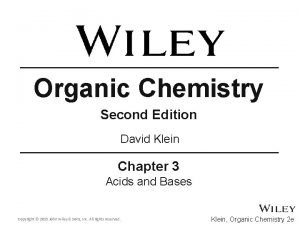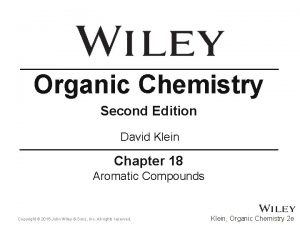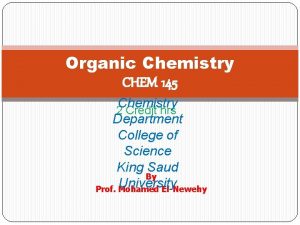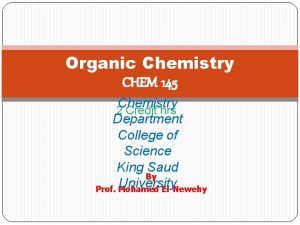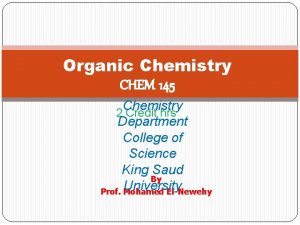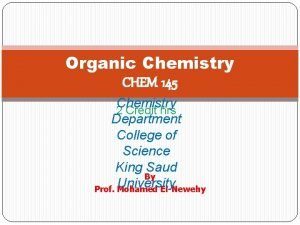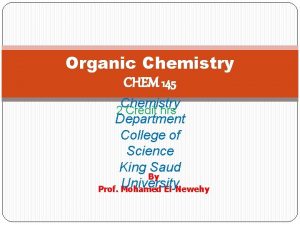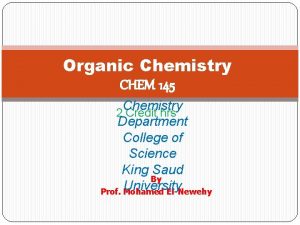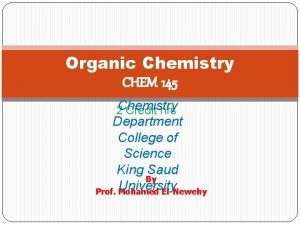Organic Chemistry CHEM 145 2 Chemistry Credit hrs






















- Slides: 22

Organic Chemistry CHEM 145 2 Chemistry Credit hrs Department College of Science King Saud By University Prof. Mohamed El-Newehy

Carboxylic Acids � All carboxylic acids contain the carboxyl group, COOH. � Depending on whether an R or an Ar. residue is attached to the carboxyl group; Carboxylic acids are classified as aliphatic or aromatic. � Aliphatic Carboxylic Acids. � Aromatic Carboxylic Acids.

Nomenclature of Carboxylic Acids � The common names of carboxylic acids all end in -ic acid. For example � Formic acid is the acid that gives the characteristic sting to an ant bite (from the Latin formica, ant). � Acetic acid is vinegar (from the Latin acetum, vinegar). � Butyric acid is the compound that gives rancid butter its putrid smell (from the Latin butyrum, butter). � Fatty acids. Long straight-chain carboxylic acids with even numbers of carbons, which were first isolated from fats and waxes. � IUPAC System �The ending -e of the corresponding alkane is replaced by Foracid. example �oic HCOOH is called methanoic acid. CH 3 COOH is called ethanoic acid.

� If substituents are present on the acid chain. �Common nomenclature Their positions are located by Greek letters; , , , …. etc IUPAC � system Numbers are used and the carboxylic carbon is numbered 1. α

� IUPAC and Common Names of Some Normal carboxylic Acids. No. of carbon Formula IUPAC name Common name 1 HCOOH Methanoic acid Formic acid 2 CH 3 COOH Ethanoic acid Acetic acid 3 CH 3 CH 2 COOH Propanoic acid Propionic acid Butanoic Butyric acid Pentanoic acid Valeric acid atoms carboxylic acid �Cylcoalkane 4 CH 3(CH 2)2 COO 5 When the carboxyl H group is attached acid to a saturated ring. CH 3(CH 2)3 COO H � Aromatic carboxylic acids are generally called by their common names.

� Dicarboxylic acids (acids that contain two carboxyl groups) are known almost exclusively by their common names. Physical Properties of Carboxylic Acids � Carboxylic bonding. acids are capable of hydrogen

� Solubility in water. �The first four aliphatic acids (formic through butyric) are completely miscible in water. �Higher members of the series are less soluble because the long alkyl chain gives them alkane like characteristics. �Aromatic acids are insoluble in water. � Boiling points. �The boiling points of carboxylic acids indicate a greater degree � of association than for alcohols of comparable molecular weights. For example, Acetic acid (mol wt = 60) boils at 118°C. n-Propyl alcohol (mol wt = 60) boils at only 97° C. �In fact, simple carboxylic acids exist as hydrogen-bonded dimers.

� The first nine aliphatic acids are colorless liquids that have sharp, acrid odors. � Pure acetic acid is called glacial acetic acid because it solidifies into ice-1 ike crystals at temperatures slightly below normal room temperature (about 17 C). � Butyric acid smells like rancid butter and strong cheese. � Acids of five to ten carbons have goat-like smells because they are present in the skin secretion of goats. � Higher acids are wax-like solids and are practically odorless. � Aromatic acids are also high-melting odorless solids.

Some Physical Properties of Acids and Alcohols of Corresponding Molecular Weights. Structure Name Mol. Wt. b. p. C Solubility in H 2 O at 25 C HCOOH CH 3 CH 2 OH Formic acid Ethyl alcohol 46 46 100 78 Very soluble CH 3 COOH CH 3 CH 2 OH Acetic acid n-Propyl alcohol 60 60 118 97 Very soluble 102 187 156 4. 0 g/100 g H 2 O 0. 6 g/100 g H 2 O Benzoic acid 122 3122 Phenylethano l 250 Insoluble CH 3(CH 2)3 COOH Valeric acid CH 3(CH 2)4 CH 2 O n-Hexyl H alcohol Ph-COOH Ph-CH 2 OH

Acid Strength � The strength of an acid depends on the extent it ionizes. � Common mineral acids, such as HCl or HNO 3, ionize completely and are considered therefore to be strong acids. � Carboxylic acids are weak acids. Because they are incompletely ionized and exist in equilibrium with a solution of their ions.

Acid Strength and Acid Structure �Carboxylic acids are much more acidic than are alcohols even though both classes of compounds contain an OH group. �Why is this so? The structures of their conjugate bases, the carboxylate anion and the alkoxide anion, �Carboxylic acids are stronger acid than alcohols because Carboxylate anions are stabilized by resonance and Alkoxide anions are not.

�Acid strength among carboxylic acids. �Generally, any factor that stabilizes the carboxylate anion of an acid will give it greater acid strength than an acid lacking that factor. �Conversely, any factor that destabilizes the carboxylate anion of an acid will make that acid less strong. �The stronger acid is the one with the electron-withdrawing group compared to unsubstituted acid. By dispersing the negative charge. � Examples of common electron-withdrawing, strengthening, groups are and acid- � Addition of any electron-donating substituent on the R (or Ar) portion of an acid decreases its acid strength relative to the parent unsubstituted acid. electron-donating �The anion. By intensifying charge. group destabilizes the carboxylate the negative

�The most common electron-donating, acid-weakening substituent is the alkyl group (methyl, propyl, and so on. �Formic acid (no alkyl group) is a stronger acid than acetic acid (one alkyl group). Comparison of Acid Strengths of Acetic Acid and Chlorinated Acetic Acids Name Structure p. Ka Relative acid strength Acetic acid CH 3 COOH 4. 7 1 Chloroacetic acid Cl. CH 2 COO H 2. 8 80 Dichloroacetic Cl 2 CHCOO 1. 3 2800 acid H Comparison of Acid Strengths of Butyric Acid and the Monochlorinated Trichloroacetic Cl 3 CCOOH 11000 0. 7 Acids Name Structure p. Ka Relative acid strength Butyric acid CH 3 CH 2 COOH 4. 82 1 α-Chlorobutyric acid CH 3 CH 2 CHCl. COO H 2. 85 92 -Chlorobutyric acid CH 3 CHCl. CH 2 COO H 4. 05 6

Preparation of Carboxylic Acids Preparation of Acids by Oxidation A. Oxidation of Primary Alcohols or Aldehydes are oxidized to carboxylic acids by potassium � Primary alcohols permanganate, KMn. O 4, or by a mixture of potassium dichromate, K 2 Cr 2 O 7, and sulfuric acid. B. Oxidation of Alkylbenzenes oxidation of alkylbenzenes yields benzoic acid. � Vigorous

Carbonation of Grignard Reagents � The addition of Grignard reagents to CO 2 in the form of dry ice proceeds in a similar fashion and yields the halomagnesium salt of a carboxylic acid. Hydrolysis of the salt gives an acid with one carbon more than � the original Grignard reagent Hydrolysis of Nitriles �Nitriles are compounds with the general formula RCN or Ar. CN. are prepared by reacting a 1 or 2 alkyl halide with a They � cyanide salt.

hydrolysis of a nitrile yields a carboxylic �Acid Alkaline hydrolysis yields a carboxylate salt. �The acid. carboxylate acid or salt contain one carbon more than the starting alkyl halide.

Reactions of Carboxylic Acids Reactions with Bases: Salt Formation �Carboxylic acids react quantitatively with bases to form watersoluble salts. �The metal cation is named first, followed by the name of the carboxylate anion. �The latter is named by dropping the -ic acid ending from the name of the parent acid and replacing it with –ate.

�Carboxylic acids will also react with a weak base like sodium bicarbonate, Na. HCO 3, to form � Water-soluble salts. Carbon dioxide � is liberated as a by- product. � Weaker acids like phenols react only with strong bases (Na. OH or KOH) and will not react with Na. HCO 3.

Carboxylic Acid Derivatives �When the OH of a carboxylic acid is replaced by a nucleophile, : Nu, a carboxylic acid derivative is produced. �The RCO- portion of acid derivatives is called the acyl group. Aromatic acid derivatives contain the aryl group. � The carboxylic acid derivatives are

Nomenclature of Acid Derivatives � Acyl chlorides, or acid chlorides, are named by replacing the ic acid ending of the parent acid by -yl chloride. � Esters are named as if they were formed from replacement of the carboxyl hydrogen by an alkyl group. �The alkyl group is named first followed by the name of the parent acid with the ending -ate in place of -ic acid.

�Amides are named by replacing the -oic acid or -ic acid of the parent acid’s name by –amide. � An anhydride is named by replacing the word acid with anhydride in the name of the acid from which it was formed.

Esters from Carboxylic Acids: Esterfication � Esters are formed by treatment a carboxylic acid with a primary or secondary alcohol. �A small amount of mineral acid catalyst (H+) is required to speed up esterification.
 11:00 in 24 hour clock
11:00 in 24 hour clock Meth eth prop but
Meth eth prop but Qualitative organic analysis
Qualitative organic analysis Organic vs inorganic chemistry
Organic vs inorganic chemistry Ib organic chemistry
Ib organic chemistry Hrs
Hrs Hrs types
Hrs types 1300 hrs
1300 hrs Hrs
Hrs 8 in 24 hour clock
8 in 24 hour clock Resolve complaint
Resolve complaint Difference between rigid and flexible pavement
Difference between rigid and flexible pavement Wake up 24 hrs
Wake up 24 hrs 1900 hrs
1900 hrs Hrs rand
Hrs rand Www.mathsrevision.com
Www.mathsrevision.com Eztable taiwan
Eztable taiwan 1300 hrs
1300 hrs Bitgain 24 hrs
Bitgain 24 hrs This can be avoided by giving credit where credit is due.
This can be avoided by giving credit where credit is due. Organic chemistry
Organic chemistry Chemistry mind map
Chemistry mind map What is organic chemistry
What is organic chemistry


